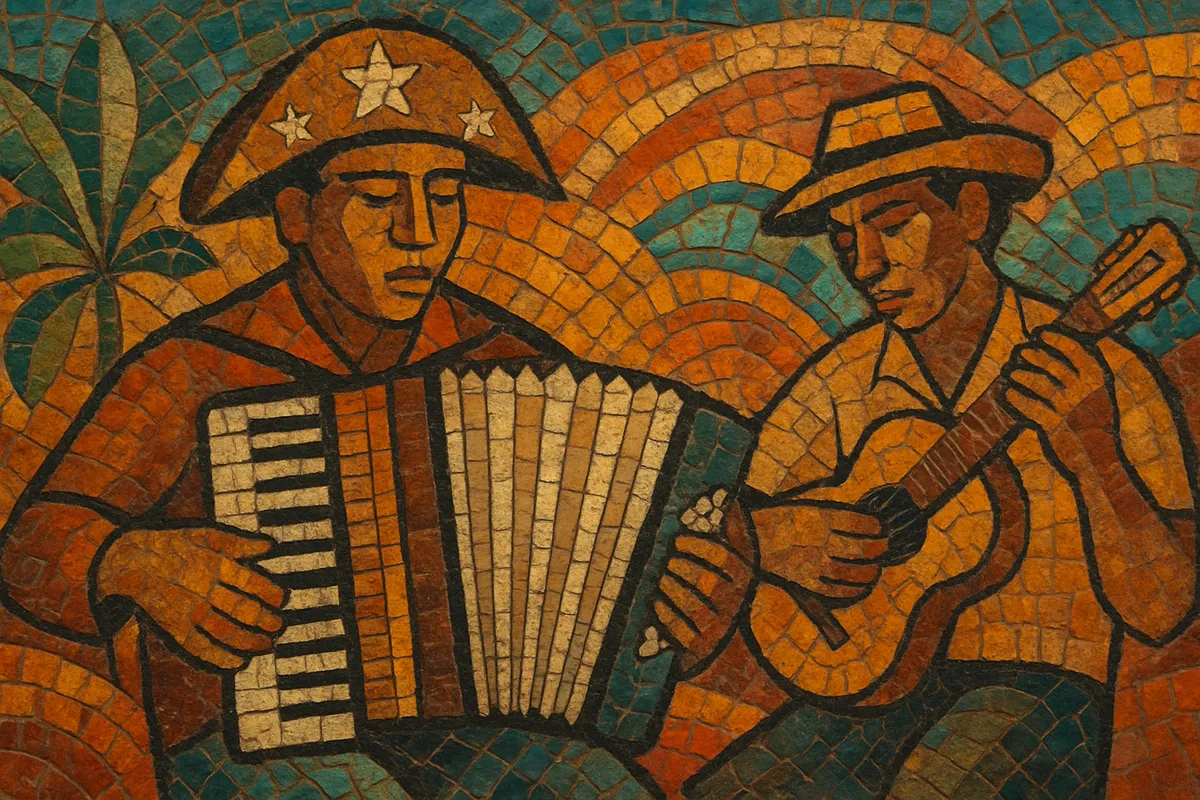Baião is a dance rhythm and song genre from Northeastern Brazil, characterized by a driving 2/4 groove led by the trio pé-de-serra: accordion (sanfona), zabumba (a double-headed bass drum), and triangle. Its hallmark is the syncopated interplay between the zabumba’s low and high strokes, a shimmering triangle ostinato, and accordion melodies that alternate between earthy, modal flavors and bright, diatonic hooks.
Developed in rural contexts and urbanized on Brazilian radio, baião became a foundational pillar for the broader forró scene. Lyrically, classic baiões often reflect the sertão (semi-arid hinterland), drought, migration, longing (saudade), and everyday love and humor. The style’s compact harmonies, strong groove, and memorable refrains helped it travel far beyond its region, shaping Brazilian popular music for decades.
Baião has roots in Northeastern Brazilian rural dances and rhythms. It emerged from the synthesis of European couple dances (polka, schottische, mazurka) with Afro-Brazilian forms like lundu and the Northeastern circle-dance lineage of coco. By the early 20th century these elements had coalesced in regional practice into characteristic rhythmic patterns and dance steps.
The genre was defined and popularized nationally in the 1940s, especially through the work of Luiz Gonzaga and his songwriting partners Humberto Teixeira and Zé Dantas. Radio, records, and cinema propelled hits like “Baião” (1946) and “Asa Branca” (1947) into the Brazilian mainstream. The trio pé-de-serra setup—accordion, zabumba, and triangle—became iconic, and baião quickly became synonymous with Northeastern identity on the national stage.
Through the 1950s and 1960s, artists such as Jackson do Pandeiro, Marinês, and Trio Nordestino diversified baião’s phrasing, vocal delivery, and dance feel. In the 1970s and beyond, Dominguinhos and Sivuca refined its harmonic palette and instrumental virtuosity, while MPB and Tropicália artists incorporated baião’s rhythms and imagery, expanding its reach. Later urban and electronic forró scenes adapted the groove, keeping baião central to Northeastern dance culture.
Baião continues to inform modern Brazilian music, from forró eletrônico and forró universitário to pop fusions and genre-crossing projects. Scenes like Mangue Beat drew on Northeastern rhythmic DNA (alongside maracatu), and more recent styles such as piseiro trace part of their lineage to baião via forró. Today baião remains a living tradition—heard at festas juninas, in concert halls, and on dancefloors—symbolizing resilience, festivity, and regional pride.
Start in 2/4, typically medium to brisk (around 100–130 BPM). The groove is defined by the zabumba’s two voices: a low, damped hit on beat 1 and a higher, sharper rim or upper-head hit emphasizing beat 2 and key offbeats. The triangle provides a glistening ostinato—steady 16ths or swung subdivisions—with light accentuation of the downbeats.
Use the trio pé-de-serra: accordion (sanfona) for melody, harmony, and bass oom-pah; zabumba for the heartbeat groove; and triangle for rhythmic texture and pulse. Guitar or cavaquinho may double harmony or add syncopated strums, but keep the accordion central.
Favor diatonic progressions (I–IV–V in major or i–VII–VI–V contours in minor). Mixolydian and Dorian colors feel idiomatic, and secondary dominants or borrowed bVII can add lift. Melodies should be singable and motif-driven, often using call-and-response between voice and accordion fills. Short turnarounds with chromatic approach tones on the accordion’s right hand create forward motion.
Let the zabumba articulate the baião pulse consistently while the triangle knits together the offbeats. Have the accordion’s left hand alternate bass and chords in a tight, percussive pattern, locking with the zabumba. Arrange verses and refrains with clear hooks; instrumental interludes or short accordion solos maintain dance energy between vocal sections.
Write about the sertão, journeys, drought and rain, community, love, humor, and longing (saudade). Use vivid imagery and plain-spoken storytelling. Strophic forms with memorable refrains work well for communal singing and dancing.
Keep percussion dry and present so the groove leads. In modern contexts, light bass reinforcement can double the zabumba’s low hits, but avoid overpowering the acoustic core. Performance should feel buoyant and propulsive, with dynamic swells into refrains and crisp articulation of syncopations.


